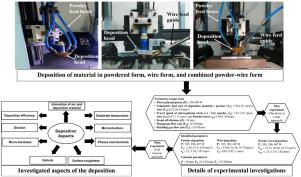CIRP Journal of Manufacturing Science and Technology ( IF 4.6 ) Pub Date : 2020-06-13 , DOI: 10.1016/j.cirpj.2020.05.008 Pravin Kumar , Neelesh Kumar Jain

|
This paper presents study on influence of different forms (i.e. powder, wire, and combined powder-wire) of Stellite-6 deposition material on arc interaction and deposition characteristics in μ-plasma transferred arc additive manufacturing (μ-PTAAM) process. It was found that (i) width of μ-plasma arc remains almost constant throughout its length for the powdered form, but it varies for wire and combined powder-wire form; (ii) the wire form resulted in the highest deposition efficiency (94.9%), substrate temperature (114.7 °C) and surface roughness (202 μm) whereas the powder form gave the highest average value of dilution (10.3%) and microhardness (588 HV), lowest substrate temperature (70.9 °C) and surface roughness (125 μm), and smallest grain size (3 μm); (iii) combined powder-wire form gave the lowest dilution (8.66%) and microhardness (534 HV), and largest grain size (7 μm); (iv) elemental composition analysis found highest inclusion of iron for the powder form; (v) phase analysis revealed that different forms of deposition material yielded same crystalline phases. This study proves that different forms of the deposition material can be used in μ-PTAAM process and combined powder-wire form the deposition material narrows the existing gaps between the wire and powder forms for various aspects of additive manufacturing.
中文翻译:

材料形态对微等离子体转移电弧添加制造过程中沉积特性的影响
本文介绍了μ-等离子转移电弧增材制造(μ-PTAAM)过程中Stellite-6沉积材料的不同形式(即粉末,金属丝和复合粉末-金属丝)对电弧相互作用和沉积特性的影响的研究。发现:(i)对于粉末形式,μ-等离子弧的宽度在其整个长度上几乎保持恒定,但是对于金属丝和混合粉末-金属丝形式,其宽度变化;(ii)线状产生最高的沉积效率(94.9%),基材温度(114.7°C)和表面粗糙度(202μm),而粉末状则产生最高的稀释平均值(10.3%)和显微硬度(588) HV),最低基板温度(70.9°C)和表面粗糙度(125μm),最小晶粒尺寸(3μm); (iii)粉末-金属丝的混合形式稀释度最低(8。66%)和显微硬度(534 HV),最大晶粒尺寸(7μm);(iv)元素组成分析发现,粉末形式的铁含量最高;(v)相分析表明,不同形式的沉积材料产生相同的结晶相。这项研究证明,在μ-PTAAM工艺中可以使用不同形式的沉积材料,而粉末-线材的组合形式的沉积材料可缩小增材制造各个方面的线材和粉末形式之间的现有间隙。











































 京公网安备 11010802027423号
京公网安备 11010802027423号